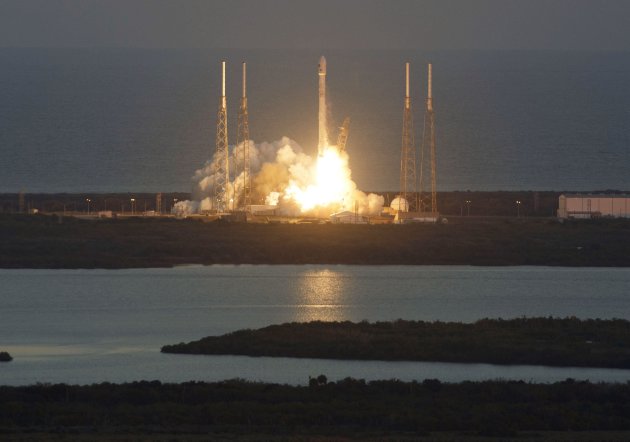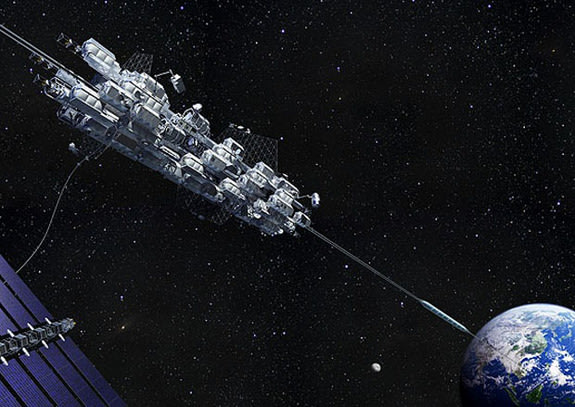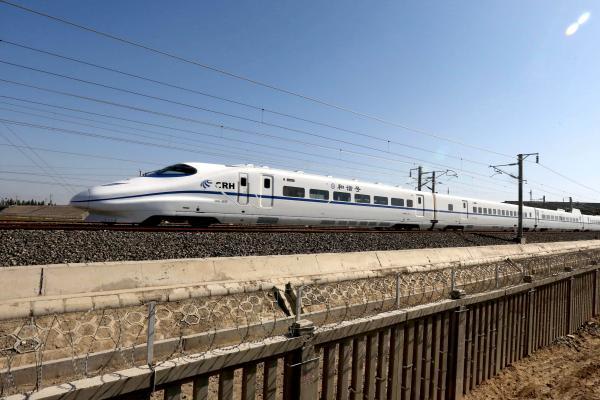
The unmanned Falcon 9 rocket lifts off from launch pad 40 at the Cape Canaveral February 11, 2015. (Reuters)
The most expensive part of any voyage into space – be it to the orbiting space station or distant Pluto – is travelling the first 160 kilometres blasting off the Earth.
On average, the cost of leaving the gravity pull of our planet and placing a communication satellite, telescope or planetary probe into space is about $10,000 per pound. Each and every large rocket launches hundreds of millions of dollars worth of equipment. With astronomical costs like these tied to today’s dependence on expendable, chemical launch vehicles, the hopes for a burgeoning space industry in the near future filled with orbiting hotels and moon bases and boots on Mars and beyond may remain stymied for generations to come unless these expenses can be brought down to Earth.
Space propulsion researchers have been coming up with blueprints for alternatives (some more realistic than others) for decades, and one particularly intriguing concept has been receiving a lot of attention recently.Going up
This past August, Ontario-based Thoth Technology designed and patented plans for erecting a 20-kilometre-high free-standing space elevator that would allow astronauts to launch into space from a platform high above the Earth.
Current chemical rockets use very expensive multiple stages to escape Earth’s gravity and get into space. This tower design would allow any launch vehicle to forego the first, most expensive stage in the rocket design, making it more cost effective.
“When the first elevator is completed, the huge reduction in cost to access Low Earth Orbit will make all existing rocket systems obsolete,” said Brendan Quine, a professor at York University and Chief Technical Officer at Thoth Technology, in an interview with Yahoo Canada.
“Our hope is that the space elevator will enable humanity to explore properly our solar system and within our lifetimes help establish permanent civilizations on the moon and Mars.”
And there are plans for using the space elevator for more than just rocket launches, says Quine. Giant towers like these could be used as lower-cost alternatives to communication satellites and even offer the general public the ultimate low-cost extreme lookout experience.
“We aim to bring the near space experience to millions of people willing to ride to the top of our elevator for a ticket price of perhaps $1000,” he added.
The company intends to use pneumatic cells composed of materials like polyethylene and kevlar to form stackable inflatable tubes that are each 150 metres long. They would then pump them up using simple gas pressure to create a strong, rigid structure capable of supporting tremendous amount of mass.
The hypothetical scenario would see astronauts ride up to the top on an electrical elevator and then from the top platform space planes launch directly to orbit, returning to the top of the tower for refueling and readied for re-flight within hours or days.
“We aim to reduce the cost of space launch by a factor of 100 by making all the component required to lift payload reusable,” explained Quine.
“From 20 km it is possible to launch in a single stage to orbit, deliver a payload or dock with a space station and then return to the top of the tower where the spaceplanes would only then require maintenance and refueling.”
Not all smooth sailing
The biggest technological challenge is the need for the tower structure to deal with strong winds at high altitudes, a monumental obstacle considering it’s basically being kept rigid with pneumatic pressurization of the tubes. The stresses would be tremendous, especially in storms like hurricanes.
Even the simple movement of climbers or elevators up and down the structure may trigger violent vibrations along the length of the structure that could initiate a total collapse.

Payloads and people get a lift off Earth in this artist's illustration by the Japan Space Elevator Association …
But Quine says they have already thought of these scenarios and the company has come up with an ingenious mitigation strategy; gyroscopes placed strategically along the spine of the tower would compensate and nullify these movements and stabilize the tower.
“The main novelty of our patent is in the harmonic control strategy that we describe that continuously monitors and corrects the structures stance in order to control it,” explained Quine.
“The center of gravity is guided actively over the base in order to null out external forces such as a hurricane.”
Up until this innovative Canadian design however, most space elevator concepts have involved exotic-sounding form of graphene, carbon nanotubes, but that technology has not been developed fully yet.
The basic design for a space elevator would consist of a 35,400 km cable extending from the surface of Earth to geosynchronous orbit. Once anchored and counterbalanced, laser-powered climbers would ascend the cable, bringing their precious cargo into space.
The big problem is that no current material exists with sufficiently high-tensile strength and sufficiently low density out of which we could construct the cable.
There's nothing in sight that's strong enough to do it — not even the much touted carbon nanotubes, which is 32 times stronger than steel.
The longest carbon nanotube that has ever been constructed is only a few inches long and a nanometer in width. But even if this material could in fact sustain the tremendous weights that would be placed on it, it will be some time yet — if ever — before engineers can scale it up to something many kilometers in length.
Thinking outside the (elevator) box
While space elevators sound innovative, they aren’t the only alternatives to rockets that have been on the drawing board. Some are more realistic than others but all of them are considered ‘green’ propulsion systems since they are safer alternatives for the environment since they avoid risks associated with the accidental exposure to toxic rocket fuel substances.

Bullet trains, like this one in China, can travel up to speeds of 320 km/h.
Magnetic launch systems: The same technology that now propels trains in Japan at super speeds holds great promise for putting small payloads into space. Current designs would be able to hurl payloads off magnetic tracks up to 23 times the speed of sound – making it unsuitable for humans or fragile instruments – but still very cost effective, with prices expected to be at least 10 times cheaper than current rockets.

NASA is now testing out a space propulsion technology originally invented by a UK scientist. (IB Times)
Laser propulsion: This method doesn’t use any explosive chemical reactions to push the rocket forward, instead using a focused laser light shining on it to propel it to space. An onboard heat exchanger could transfer the radiation energy to a liquid propellant, even something as simple as hydrogen.
The main cost savings with laser propulsion would be from eliminating the need to carry the heavy chemical fuels and instead use that freed-up space for payloads. The limiting factor with this technology is that it would take a large number of expensive lasers – an array at least as large as a golf course – to place even a suitcase-sized satellite into orbit.

Space gun: Like something out of a classic sci-fi novel, this ambitious project is basically a cannon on steroids that shoots payloads like a bullet straight into space. Like with the magnetic system, the G-forces would be so high, it would be unsuitable for human travelers. The projectile, or satellite, would also need a traditional rocket stage to propel it into a stable orbit, otherwise it would only reach a sub-orbital path that brings it back to Earth.
Amazingly, this space technology was tested out by both the United States and Canada in the 1960s in a project dubbed HARP. A 40 centimetre-wide cannon was built that managed to shoot a 400 pound projectile to a 177 km altitude. Even the late Iraqi dictator Saddam Hussein was working on just such a cannon codenamed Project Babylon, but the project was grounded when its chief scientific mind, a Canadian artillery expert, was assassinated prior to its completion.
Who will win the new space race?
There is no doubt that there are a lot of factors to consider in developing an alternative to our current launch systems including economics, practicality, and most importantly, technical feasibility.
But when it comes to the ambitious Canadian space elevator design, there is a fair chance that at least a variation of it might actually be built. In many respects, it’s about sheer willpower of wanting to make this happen. At this point with the patent being granted, it’s important to remember that, so far, it’s just an engineering theory we are talking about; albeit an amazing design based on the latest scientific technology.
The next steps will really put the idea to a real world test as the company would like to build a smaller demonstration tower to test the concept. Quine says they plan to license the technology “to a wide range of interested companies”
If they do get the funding they estimate the project will cost between $5 billion and $10 billion, and it could take three to five years to complete the demonstration tower and perhaps another few years to build it at full scale.
So perhaps in the not-so-distant future, we may hitch a ride on an elevator into the stratosphere before taking off on a space plane . Mind boggling
No comments:
Post a Comment
Through this ever open gate
None come too early
None too late
Thanks for dropping in ... the PICs